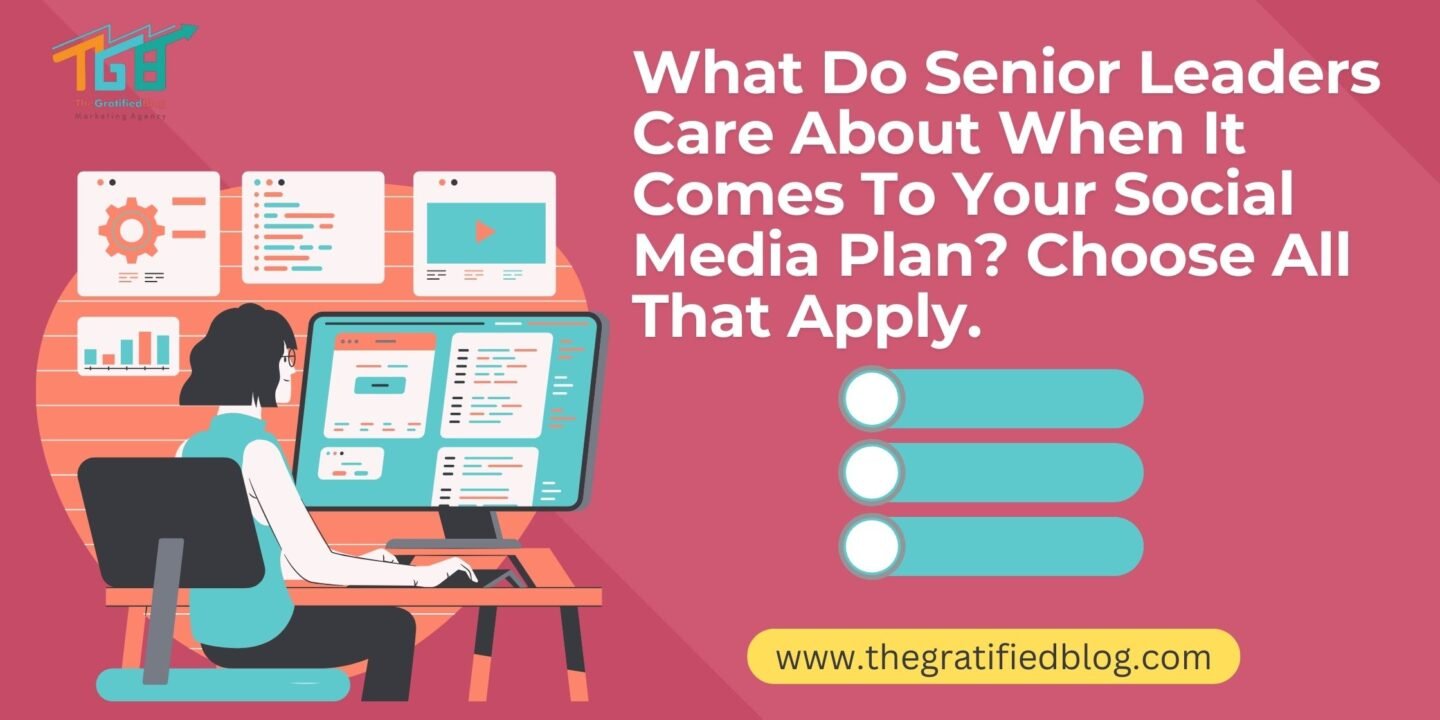
In today’s dynamic and interconnected digital landscape, a meticulously crafted social media plan is indispensable to any organization’s comprehensive strategy. To ensure the triumph of your social media initiatives, it is vital to harmonize your plan with the objectives and priorities of senior leaders, given their pivotal role in guiding the organization toward success.
So, what do senior leaders care about when it comes to your social media plan? Choose all that apply. This alignment ensures that your efforts in social media are synchronized and practical, supporting the company’s overarching mission and vision. This, in turn, leads to more substantial achievements and positive outcomes.
In this context, this article delves into the significance of such alignment and explores the essential factors senior leaders consider when evaluating and shaping a social media strategy.
What Constitutes A Social Media Marketing Plan?
A social media marketing plan is an inclusive strategy detailing an organization’s goals, objectives, and tactics for utilizing social media platforms to achieve specific marketing and business objectives. It typically includes a detailed roadmap for content creation, posting schedules, audience engagement, and metrics for measuring the success of social media efforts. The plan considers the target audience, platform selection, content strategies, budget allocation, and the timeline for implementation.
Social media marketing plans are crucial for creating a cohesive and effective online presence, building brand awareness, driving traffic, and achieving various marketing goals in the digital age.
So, let’s get started with questions:
What Do Senior Leaders Care About When It Comes To Your Social Media Plan? Choose All That Apply.
- Sentiment
- Competitive advantage✅
- Click-through rates
- Customer satisfaction✅
- Number of social followers
Senior leaders, such as CEOs, CFOs, and other high-ranking executives, have a vested interest in the success of an organization’s social media plan. They are concerned with several key aspects directly impacting the company’s performance. Here are some of the other main concerns that senior leaders care about when it comes to your social media plan:
- Brand Reputation: Protecting and enhancing the organization’s brand reputation is a top priority. Senior leaders are keen to ensure that the content and interactions on social media platforms align with the company’s values and messaging. They understand that a positive brand image is vital for customer trust, loyalty, and long-term success.
- Return on Investment (ROI): Senior leaders want to see a clear and measurable return on the resources invested in social media. They expect the social media plan to contribute to the company’s bottom line. Metrics like lead generation, customer acquisition, and revenue growth are exciting. Demonstrating the impact of social media efforts through data and analytics is crucial.
- Risk Management: Social media can be a double-edged sword, with the potential for both opportunities and risks. Senior leaders are concerned about managing reputational, legal, and security risks. They expect the social media plan to include strategies for handling crises, addressing negative feedback, and safeguarding sensitive information.
- Compliance and Regulations: In industries with regulatory requirements, senior leaders ensure that the organization’s social media activities adhere to relevant laws and regulations. Non-compliance may lead to legal and financial consequences repercussions, which senior leaders aim to avoid.
- Strategic Alignment: Senior leaders want to see that the social media plan aligns with the organization’s overall strategic goals. They expect social media to support and amplify key business objectives, whether expanding into new markets, launching new products, or improving customer engagement.
- Resource Allocation: Senior leaders often make decisions regarding budget allocation and want to ensure that the resources devoted to social media are justified. They seek a balance between investing in social media and other critical business functions.
- Competitive Analysis: Understanding how the organization’s social media performance compares to competitors is vital. Senior leaders are interested in tracking and benchmarking key performance indicators against industry standards and rivals.
- Customer Insights: Social media is valuable for customer feedback and insights. Senior leaders expect the social media plan to provide actionable data to inform strategic decisions and assist the organization in gaining a deeper understanding of customer needs and preferences.
- Innovation and Adaptation: Given the ever-evolving nature of social media platforms, senior leaders look for adaptability and innovation in the plan. They want to see that the organization stays ahead of trends and makes necessary adjustments to remain relevant.
- Employee Advocacy: Senior leaders recognize the importance of employee advocacy on social media. They encourage employees to be brand ambassadors and want to ensure that the social media plan includes guidelines and support for employee engagement.
What Is The Role Of Senior Leaders In Leadership Development?
Senior leaders play a crucial role in leadership development within an organization. Their involvement and commitment to nurturing future leaders profoundly impact the organization’s long-term success. Here are some key roles and responsibilities senior leaders have in leadership development:
- Setting the Vision and Strategy:
- Senior leaders define the organization’s long-term vision and strategy. This vision guides leadership development initiatives, ensuring they align with the company’s goals.
- Role Modeling:
- Senior leaders set an example for aspiring leaders. Their behavior, work ethic, and ethical standards are models for others.
- Mentoring and Coaching:
- Senior leaders often take on the role of mentors or coaches, providing guidance, feedback, and support to emerging leaders. This one-on-one guidance can be invaluable in developing leadership skills.
- Succession Planning:
- Senior leaders are responsible for identifying potential organizational leaders and creating succession plans. This involves assessing and preparing employees for leadership roles.
- Leadership Training and Programs:
- Senior leaders can champion and support leadership development programs, workshops, and training initiatives. They may even be involved in designing or delivering leadership training themselves.
- Feedback and Evaluation:
- Senior leaders provide constructive feedback to emerging leaders, Aiding them in identifying their strengths and areas that need improvement. Regular performance evaluations are part of this process.
- Creating a Learning Culture:
- They foster continuous learning and development. A culture that encourages employee ownership of their responsibilities and leadership growth.
- Resource Allocation:
- Senior leaders allocate resources to leadership development programs and initiatives, including time and budget. They ensure that these programs have the necessary support to succeed.
- Promoting Diversity and Inclusion:
- They champion diversity and inclusion in leadership roles and support initiatives to create a more diverse leadership team.
- Communication and Engagement:
- Senior leaders communicate the importance of leadership development to the organization and engage with potential leaders to understand their aspirations and concerns.
What’s The Biggest Challenge That Most Social Media Practitioners Have?
Social media practitioners face various challenges in their roles, but one of the most significant and common challenges is keeping up with the ever-evolving landscape of social media. The digital world is constantly changing, and social media platforms, algorithms, user behaviors, and best practices are continually shifting. Here are some specific aspects of this challenge:
- Platform Changes and Updates: Social media platforms like Facebook, Instagram, Twitter, and LinkedIn frequently update their algorithms and features. Practitioners must adapt to these changes to effectively reach their target audience.
- Emerging Platforms: The continuous emergence of new social media platforms and trends makes it challenging to decide where to allocate resources and which platforms are worth exploring.
- Content Trends: The types of content that perform well on social media can change rapidly. Staying current with content trends, such as video, live streaming, stories, and short-form content, is crucial.
- Audience Behavior: Understanding how users interact with social media is vital. User behavior, preferences, and expectations can change, and practitioners must keep up with these shifts.
- Analytics and Measurement: Measuring the effectiveness of social media efforts is complex, and practitioners need to be proficient in using analytics tools and interpreting data to make informed decisions.
- Privacy and Data Regulation: Privacy concerns and data protection regulations like GDPR and CCPA have become more stringent. Practitioners must stay informed and ensure their practices comply with these laws.
- Algorithm Changes: Social media platforms use algorithms to determine what content users see. Changes in these algorithms can significantly impact the reach and engagement of content, making it essential to adapt strategies accordingly.
- Adaptation to Trends: Keeping up with social media trends and utilizing them effectively requires constant learning and experimentation. Practitioners must be open to new ideas and willing to take calculated risks.
- Competitive Landscape: Monitoring competitors and industry leaders is crucial to stay competitive. Practitioners must know what others are doing and find ways to differentiate their brand or content.
- Time Management: Managing social media can consume a significant amount of time. Practitioners often need to juggle multiple platforms, create content, engage with the audience, and analyze results, which can be overwhelming.
- They are consistently maintaining high quality, engaging, and challenging. Practitioners must strike a balance between quantity and quality.
- Budget Constraints: Many social media practitioners work with limited budgets, making it challenging to run effective paid advertising campaigns or invest in advanced tools and resources.
Mitigating Social Media Risks: Senior Leaders’ Top Concerns
Mitigating social media risks is a top concern for senior leaders in many organizations due to the potential for reputational damage, legal issues, and other negative impacts. Here are some common social media risks and strategies senior leaders use to address them:
- Reputation Management:
- Concern: Negative comments, misinformation, or controversial content can harm an organization’s reputation.
- Mitigation: Senior leaders establish clear social media guidelines and policies. They promptly monitor and address negative comments, engage in open and transparent communication, and build a positive online reputation.
- Data Privacy and Security:
- Concern: Data breaches and privacy violations are significant risks on social media, especially when handling customer data.
- Mitigation: Senior leaders implement robust data protection measures, ensure compliance with data protection regulations (e.g., GDPR, CCPA), and educate employees on privacy best practices.
- Legal Compliance:
- Concern: Violations of intellectual property rights, defamation, and other legal issues can lead to lawsuits and financial losses.
- Mitigation: Senior leaders work with legal teams to establish guidelines for legal compliance. They train employees on copyright and trademark issues, monitor content for potential violations, and take swift action to rectify any breaches.
- Crisis Management:
- Concern: Social media can amplify crises and rapidly damage an organization’s reputation.
- Mitigation: Senior leaders develop crisis management plans that include social media-specific strategies. They monitor social media for emerging crises, respond quickly and transparently, and maintain a consistent crisis communication strategy.
- Cybersecurity:
- Concern: Social media accounts can be vulnerable to hacking, leading to unauthorized access and misuse.
- Mitigation: Senior leaders ensure strong cybersecurity measures, like two-factor authentication, are in place. They educate employees on safe online practices to prevent hacking attempts.
- Employee Conduct:
- Concern: Inappropriate employee behavior on social media can negatively impact the organization.
- Mitigation: Senior leaders establish clear social media guidelines and educate employees on online conduct. They encourage responsible use of social media and address violations appropriately.
- Social Engineering:
- Concern: Scammers and malicious actors can impersonate employees or organizations on social media for fraud.
- Mitigation: Senior leaders educate employees about social engineering risks and encourage vigilance. They establish verification processes for official social media accounts to prevent impersonation.
- False Information and Misinformation:
- Concern: The spread of false or misleading information can harm an organization’s credibility.
- Mitigation: Senior leaders promote fact-checking and accuracy in social media communication. They provide precise and reliable information, address inaccuracies promptly, and engage with credible sources.
- Monitoring and Compliance:
- Concern: Ensuring consistent social media use and policy compliance across the organization can be challenging.
- Mitigation: Senior leaders implement monitoring tools to track and measure social media activities. They establish regular compliance checks and provide ongoing training and guidance to employees.
- Employee Advocacy:
- Concern: Encouraging employees to be advocates on social media carries potential risks if not managed properly.
- Mitigation: Senior leaders provide guidelines and training for employee advocacy programs. They monitor employee advocacy efforts and ensure they align with the organization’s values and objectives.
FAQs
Q3. What Are The Two Most Important Things To Remember When Developing A HubSpot Social Media Strategy?
A. When developing a HubSpot social media strategy, two of the most important things to keep in mind are:
- Alignment with Overall Business Goals: Your social media strategy should align closely with your organization’s broader business objectives. Before diving into social media planning, it’s crucial to comprehend how social media can contribute to your company’s growth, whether it’s increasing brand awareness, driving lead generation, supporting customer service, or achieving other specific goals. This alignment guarantees that your efforts in social media are synchronized and directly impact the bottom line.
- Audience-Centric Approach: Success on social media relies heavily on understanding your target audience and tailoring Tailor your content and engagement strategies according to their preferences and needs. Create buyer personas to identify your ideal social media audience, research their behaviors and interests, and develop content that resonates with them. Engage in active two-way communication to build relationships and foster a community around your brand. A customer-centric approach ensures that your social media strategy connects with your audience meaningfully.
Q2. What Crucial Thing Should Senior Leaders Know?
A. One crucial thing that senior leaders should know is the significance of adaptability and continuous learning. In today’s rapidly changing business environment, adapting to emerging technologies, market dynamics, and customer preferences is crucial for an organization’s success.
Q3. How Could Senior Leadership Improve?
A. Senior leadership can improve through continuous learning, adaptability, fostering a culture of innovation, effective communication, embracing diversity and inclusion, and modeling ethical behavior.
Conclusion
Senior leaders are deeply concerned about various aspects of your social media plan, including reputation management, data privacy, legal compliance, crisis management, and more. Understanding their priorities and addressing these concerns is crucial for the effectiveness of your social media strategy.
You are encouraged to share your thoughts and experiences with us. What other concerns do you believe senior leaders have regarding social media plans, and how do you think organizations can effectively address them? Please leave your comments on our blog to continue this valuable discussion.








No Comments